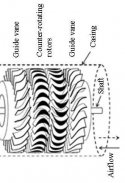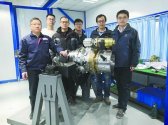There are many ways of taking advantage of counter-rotation in a gas turbine engine, without a terminologically accurate translation it is hard to know what is being done here.
Counter-rotating LP and HP shafts in two (or three) spool configurations are commonplace these days. There are several advantages, one or the other of which is the reason for adoption depending on whether it is a civilian or military design. In the former case, the low aerodynamic loading improves component efficiency, though at the cost of elevated relative speed in any inter-shaft bearings. Military engines with counter-rotation mitigate gyroscopic effects during low speed maneuvers, the extreme case (and AFAIK the first adopter) being the VTOL Harrier and its Bristol-Siddeley Pegasus.
This layout opens up the opportunity to do away with the stator stage between the high and low pressure turbine altogether, saving quite a bit of weight. However, this limits LP turbine loading, so is not an option for high-BPR airliner engines. Examples are the GE F136 and F136 as well as numerous small turbines like the Soviet TS-21 APU.
Counter-rotating compressors have also been tried, though the higher number of stages than in turbines makes this either cumbersome or virtually inconsequential in effect. The best known example also being one of the earliest turbofans ever built, the WWII German DB 007 - which was a bit crazy, to be frank. Curiously enough, the turbine was single-stage, with basically half the compressor stages (in alternation) being driven directly in one direction on a central shaft, the other half in the opposite sense on the inside of a hollow drum via a gearbox!
The increased relative rotational speed between the stages would enable higher stage pressure ratios and therefore potentially lower stage counts for a given OPR specification. But with simple two-spool engines such as the EJ200 and Izd. 30 nowadays achieving PRs around 30 in as few as 8 stages, I don't quite see the point.


